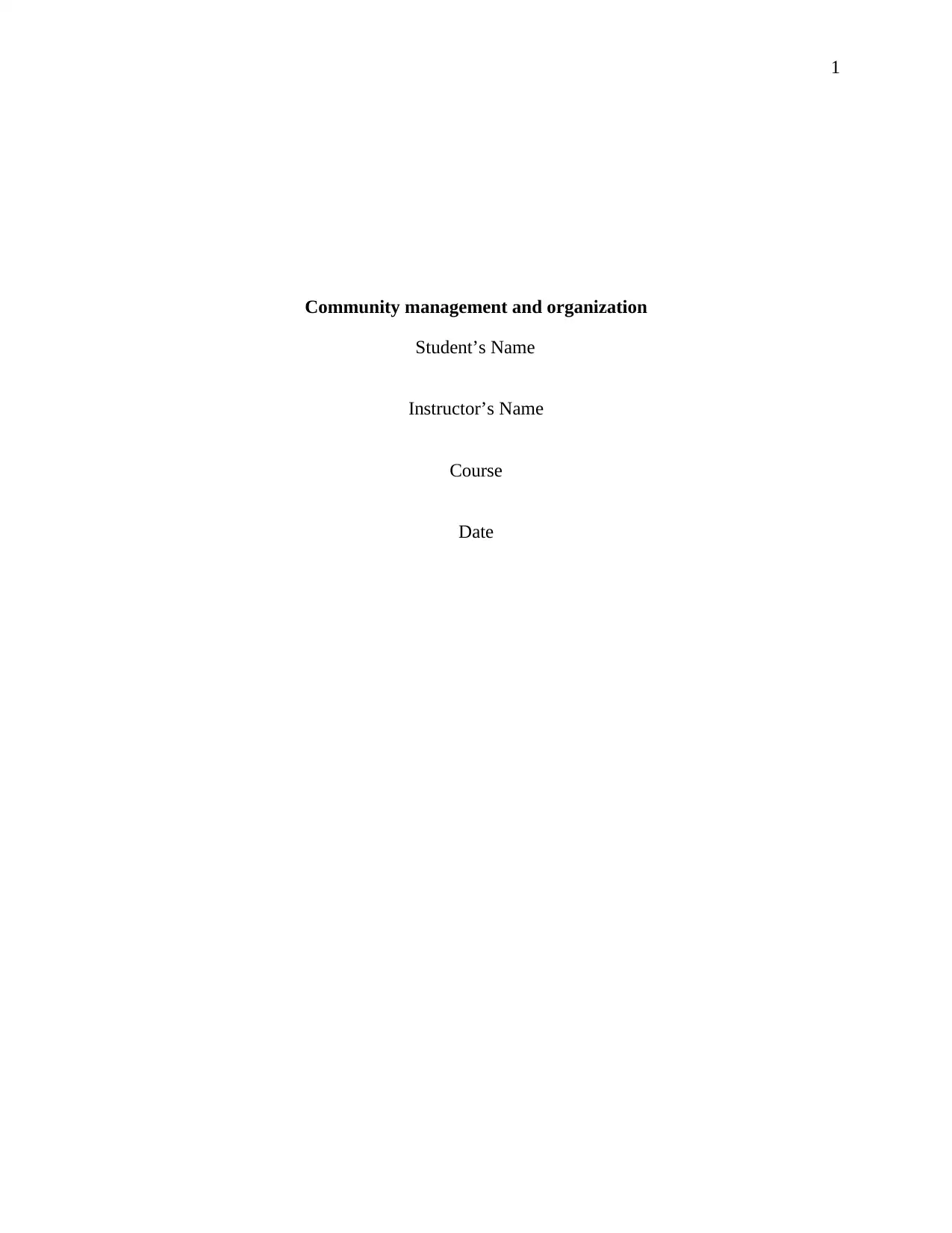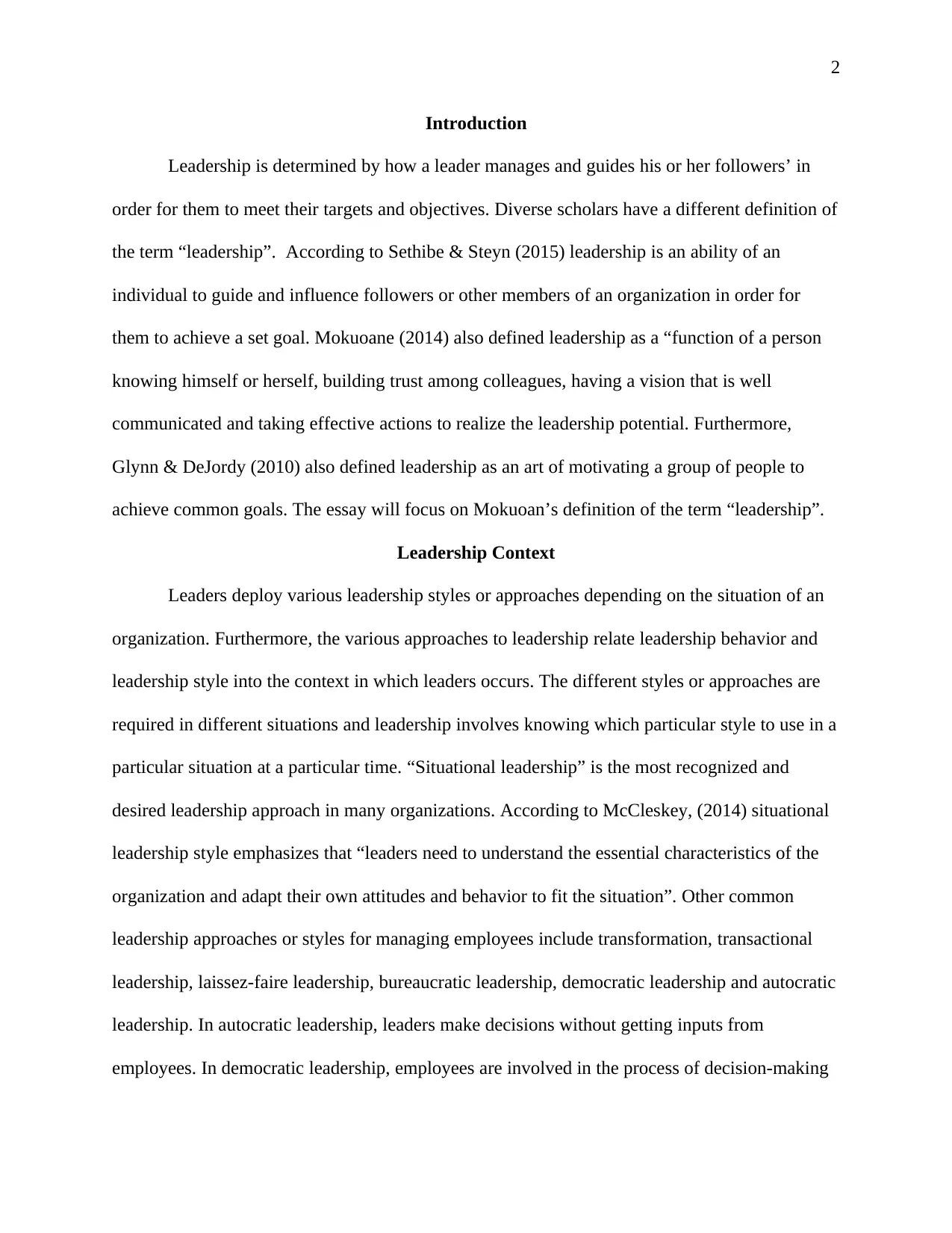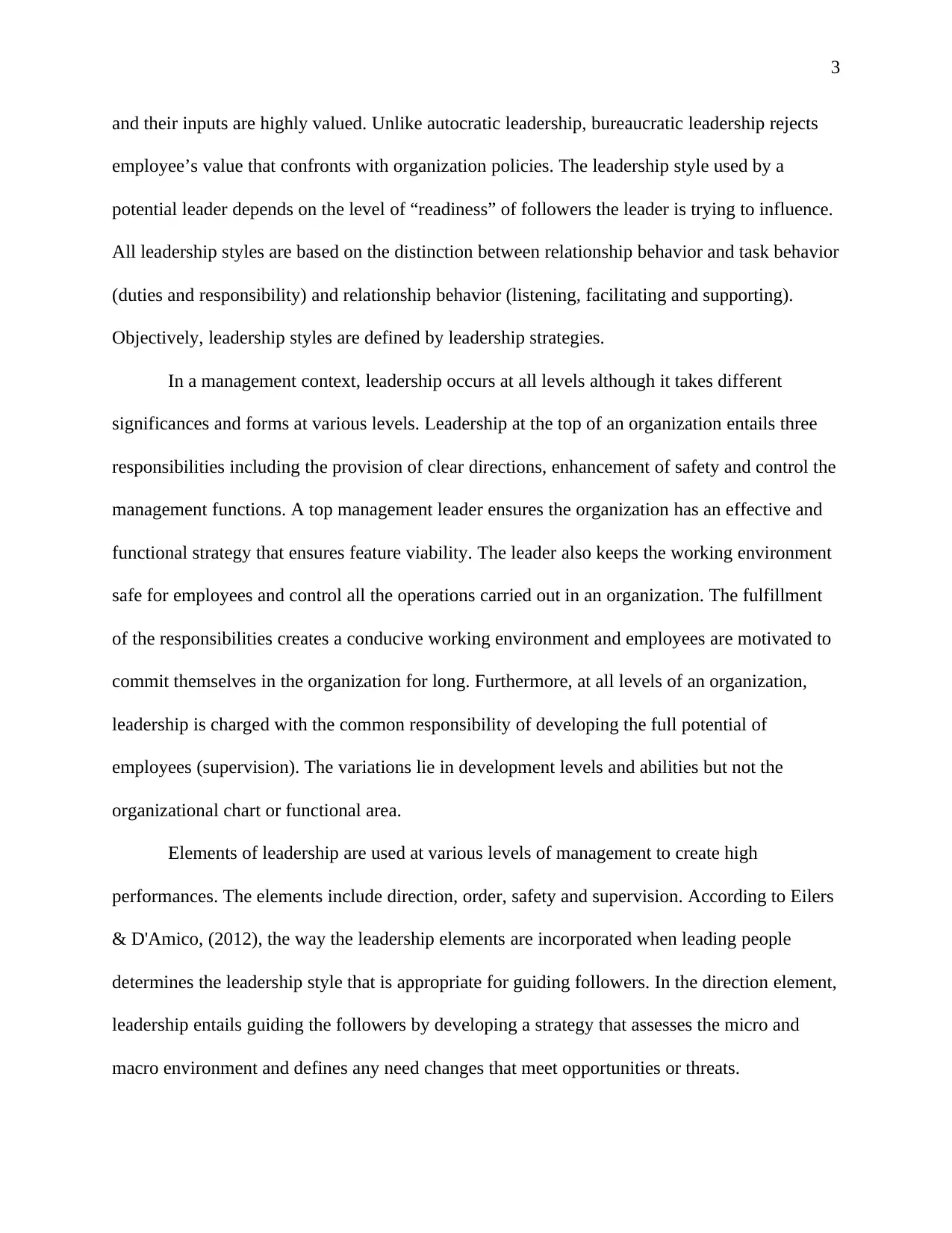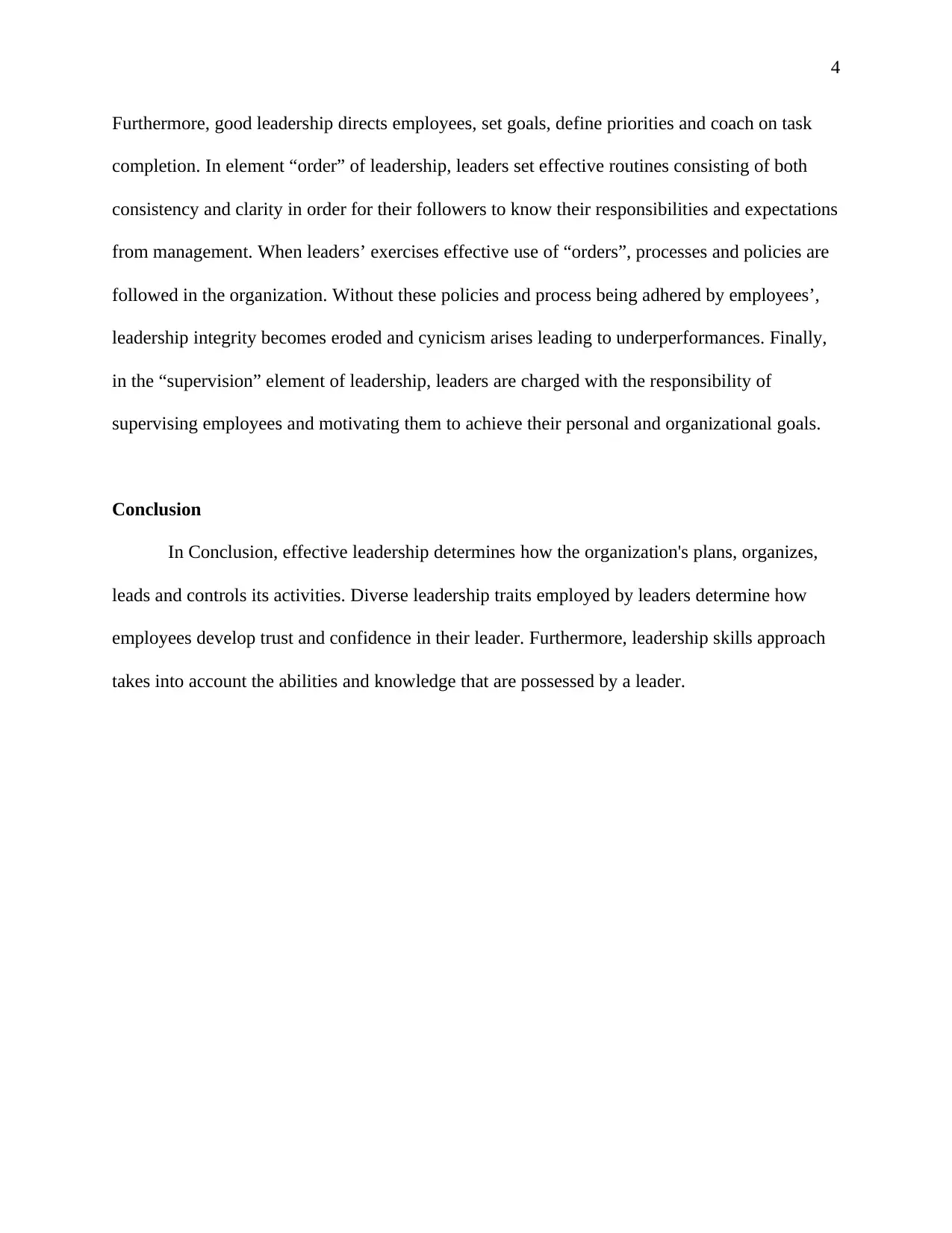Leadership in Community Management: Impact on Organizational Goals
VerifiedAdded on 2023/04/11
|5
|866
|411
Essay
AI Summary
This essay delves into the concept of leadership, particularly within the context of community management and organizational objectives, drawing upon Mokuoane's definition of leadership centered on self-awareness, trust-building, vision communication, and effective action. It examines various leadership styles, emphasizing situational leadership's adaptability to organizational characteristics, and contrasts it with transformational, transactional, autocratic, democratic, bureaucratic, and laissez-faire approaches. The essay highlights the importance of understanding follower readiness and balancing task-oriented and relationship-oriented behaviors. It further discusses leadership responsibilities at different organizational levels, focusing on direction, order, safety, and supervision as key elements, and concludes that effective leadership, incorporating these elements, is crucial for organizational success by fostering trust, motivation, and goal achievement among employees. Desklib provides access to this and many other solved assignments.

1
Community management and organization
Student’s Name
Instructor’s Name
Course
Date
Community management and organization
Student’s Name
Instructor’s Name
Course
Date
Paraphrase This Document
Need a fresh take? Get an instant paraphrase of this document with our AI Paraphraser

2
Introduction
Leadership is determined by how a leader manages and guides his or her followers’ in
order for them to meet their targets and objectives. Diverse scholars have a different definition of
the term “leadership”. According to Sethibe & Steyn (2015) leadership is an ability of an
individual to guide and influence followers or other members of an organization in order for
them to achieve a set goal. Mokuoane (2014) also defined leadership as a “function of a person
knowing himself or herself, building trust among colleagues, having a vision that is well
communicated and taking effective actions to realize the leadership potential. Furthermore,
Glynn & DeJordy (2010) also defined leadership as an art of motivating a group of people to
achieve common goals. The essay will focus on Mokuoan’s definition of the term “leadership”.
Leadership Context
Leaders deploy various leadership styles or approaches depending on the situation of an
organization. Furthermore, the various approaches to leadership relate leadership behavior and
leadership style into the context in which leaders occurs. The different styles or approaches are
required in different situations and leadership involves knowing which particular style to use in a
particular situation at a particular time. “Situational leadership” is the most recognized and
desired leadership approach in many organizations. According to McCleskey, (2014) situational
leadership style emphasizes that “leaders need to understand the essential characteristics of the
organization and adapt their own attitudes and behavior to fit the situation”. Other common
leadership approaches or styles for managing employees include transformation, transactional
leadership, laissez-faire leadership, bureaucratic leadership, democratic leadership and autocratic
leadership. In autocratic leadership, leaders make decisions without getting inputs from
employees. In democratic leadership, employees are involved in the process of decision-making
Introduction
Leadership is determined by how a leader manages and guides his or her followers’ in
order for them to meet their targets and objectives. Diverse scholars have a different definition of
the term “leadership”. According to Sethibe & Steyn (2015) leadership is an ability of an
individual to guide and influence followers or other members of an organization in order for
them to achieve a set goal. Mokuoane (2014) also defined leadership as a “function of a person
knowing himself or herself, building trust among colleagues, having a vision that is well
communicated and taking effective actions to realize the leadership potential. Furthermore,
Glynn & DeJordy (2010) also defined leadership as an art of motivating a group of people to
achieve common goals. The essay will focus on Mokuoan’s definition of the term “leadership”.
Leadership Context
Leaders deploy various leadership styles or approaches depending on the situation of an
organization. Furthermore, the various approaches to leadership relate leadership behavior and
leadership style into the context in which leaders occurs. The different styles or approaches are
required in different situations and leadership involves knowing which particular style to use in a
particular situation at a particular time. “Situational leadership” is the most recognized and
desired leadership approach in many organizations. According to McCleskey, (2014) situational
leadership style emphasizes that “leaders need to understand the essential characteristics of the
organization and adapt their own attitudes and behavior to fit the situation”. Other common
leadership approaches or styles for managing employees include transformation, transactional
leadership, laissez-faire leadership, bureaucratic leadership, democratic leadership and autocratic
leadership. In autocratic leadership, leaders make decisions without getting inputs from
employees. In democratic leadership, employees are involved in the process of decision-making

3
and their inputs are highly valued. Unlike autocratic leadership, bureaucratic leadership rejects
employee’s value that confronts with organization policies. The leadership style used by a
potential leader depends on the level of “readiness” of followers the leader is trying to influence.
All leadership styles are based on the distinction between relationship behavior and task behavior
(duties and responsibility) and relationship behavior (listening, facilitating and supporting).
Objectively, leadership styles are defined by leadership strategies.
In a management context, leadership occurs at all levels although it takes different
significances and forms at various levels. Leadership at the top of an organization entails three
responsibilities including the provision of clear directions, enhancement of safety and control the
management functions. A top management leader ensures the organization has an effective and
functional strategy that ensures feature viability. The leader also keeps the working environment
safe for employees and control all the operations carried out in an organization. The fulfillment
of the responsibilities creates a conducive working environment and employees are motivated to
commit themselves in the organization for long. Furthermore, at all levels of an organization,
leadership is charged with the common responsibility of developing the full potential of
employees (supervision). The variations lie in development levels and abilities but not the
organizational chart or functional area.
Elements of leadership are used at various levels of management to create high
performances. The elements include direction, order, safety and supervision. According to Eilers
& D'Amico, (2012), the way the leadership elements are incorporated when leading people
determines the leadership style that is appropriate for guiding followers. In the direction element,
leadership entails guiding the followers by developing a strategy that assesses the micro and
macro environment and defines any need changes that meet opportunities or threats.
and their inputs are highly valued. Unlike autocratic leadership, bureaucratic leadership rejects
employee’s value that confronts with organization policies. The leadership style used by a
potential leader depends on the level of “readiness” of followers the leader is trying to influence.
All leadership styles are based on the distinction between relationship behavior and task behavior
(duties and responsibility) and relationship behavior (listening, facilitating and supporting).
Objectively, leadership styles are defined by leadership strategies.
In a management context, leadership occurs at all levels although it takes different
significances and forms at various levels. Leadership at the top of an organization entails three
responsibilities including the provision of clear directions, enhancement of safety and control the
management functions. A top management leader ensures the organization has an effective and
functional strategy that ensures feature viability. The leader also keeps the working environment
safe for employees and control all the operations carried out in an organization. The fulfillment
of the responsibilities creates a conducive working environment and employees are motivated to
commit themselves in the organization for long. Furthermore, at all levels of an organization,
leadership is charged with the common responsibility of developing the full potential of
employees (supervision). The variations lie in development levels and abilities but not the
organizational chart or functional area.
Elements of leadership are used at various levels of management to create high
performances. The elements include direction, order, safety and supervision. According to Eilers
& D'Amico, (2012), the way the leadership elements are incorporated when leading people
determines the leadership style that is appropriate for guiding followers. In the direction element,
leadership entails guiding the followers by developing a strategy that assesses the micro and
macro environment and defines any need changes that meet opportunities or threats.
⊘ This is a preview!⊘
Do you want full access?
Subscribe today to unlock all pages.

Trusted by 1+ million students worldwide

4
Furthermore, good leadership directs employees, set goals, define priorities and coach on task
completion. In element “order” of leadership, leaders set effective routines consisting of both
consistency and clarity in order for their followers to know their responsibilities and expectations
from management. When leaders’ exercises effective use of “orders”, processes and policies are
followed in the organization. Without these policies and process being adhered by employees’,
leadership integrity becomes eroded and cynicism arises leading to underperformances. Finally,
in the “supervision” element of leadership, leaders are charged with the responsibility of
supervising employees and motivating them to achieve their personal and organizational goals.
Conclusion
In Conclusion, effective leadership determines how the organization's plans, organizes,
leads and controls its activities. Diverse leadership traits employed by leaders determine how
employees develop trust and confidence in their leader. Furthermore, leadership skills approach
takes into account the abilities and knowledge that are possessed by a leader.
Furthermore, good leadership directs employees, set goals, define priorities and coach on task
completion. In element “order” of leadership, leaders set effective routines consisting of both
consistency and clarity in order for their followers to know their responsibilities and expectations
from management. When leaders’ exercises effective use of “orders”, processes and policies are
followed in the organization. Without these policies and process being adhered by employees’,
leadership integrity becomes eroded and cynicism arises leading to underperformances. Finally,
in the “supervision” element of leadership, leaders are charged with the responsibility of
supervising employees and motivating them to achieve their personal and organizational goals.
Conclusion
In Conclusion, effective leadership determines how the organization's plans, organizes,
leads and controls its activities. Diverse leadership traits employed by leaders determine how
employees develop trust and confidence in their leader. Furthermore, leadership skills approach
takes into account the abilities and knowledge that are possessed by a leader.
Paraphrase This Document
Need a fresh take? Get an instant paraphrase of this document with our AI Paraphraser

5
References
Eilers, L. H., & D'Amico, M. (2012). Essential leadership elements in implementing common
core state standards. Delta Kappa Gamma Bulletin, 78(4), 46.
Glynn, M. A., & DeJordy, R. (2010). Leadership through an organization behavior lens.
Handbook of leadership theory and practice, 119-157.
McCleskey, J. A. (2014). Situational, transformational, and transactional leadership and
leadership development. Journal of Business Studies Quarterly, 5(4), 117.
Mokuoane, M. L. (2014). The effect of work-stress and emotional intelligence on self-leadership
amongst nurses in leadership positions in the Ministry of Health and Social Welfare in
Lesotho (Doctoral dissertation, University of the Free State).
Sethibe, T., & Steyn, R. (2015). The relationship between leadership styles, innovation and
organisational performance: A systematic review. South African Journal of Economic
and Management Sciences, 18(3), 325-337.
References
Eilers, L. H., & D'Amico, M. (2012). Essential leadership elements in implementing common
core state standards. Delta Kappa Gamma Bulletin, 78(4), 46.
Glynn, M. A., & DeJordy, R. (2010). Leadership through an organization behavior lens.
Handbook of leadership theory and practice, 119-157.
McCleskey, J. A. (2014). Situational, transformational, and transactional leadership and
leadership development. Journal of Business Studies Quarterly, 5(4), 117.
Mokuoane, M. L. (2014). The effect of work-stress and emotional intelligence on self-leadership
amongst nurses in leadership positions in the Ministry of Health and Social Welfare in
Lesotho (Doctoral dissertation, University of the Free State).
Sethibe, T., & Steyn, R. (2015). The relationship between leadership styles, innovation and
organisational performance: A systematic review. South African Journal of Economic
and Management Sciences, 18(3), 325-337.
1 out of 5
Related Documents
Your All-in-One AI-Powered Toolkit for Academic Success.
+13062052269
info@desklib.com
Available 24*7 on WhatsApp / Email
![[object Object]](/_next/static/media/star-bottom.7253800d.svg)
Unlock your academic potential
Copyright © 2020–2025 A2Z Services. All Rights Reserved. Developed and managed by ZUCOL.





